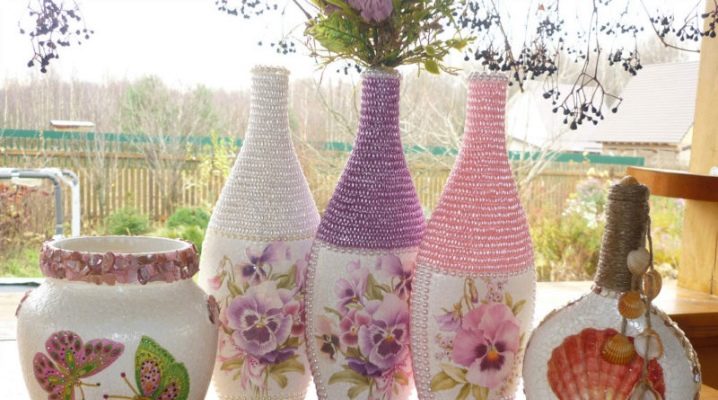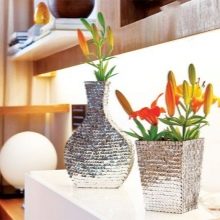DIY vase decor: ideas and tips for making

Often, a simple interior accessory can become its highlight. Take at least an ordinary floor vase. In the right hands, it can become a real work of art. The material of this article will tell you how to make it such.



Decoration features
Decorating a vase with your own hands is a creative and exciting process. However, not everything that the master wants to do will look harmonious in the interior. The decor should be selected taking into account the peculiarities of the existing style. This is how the vase will look not only expressively, but also appropriate against the general background.
You can use different materials for decoration. As a rule, most of them are on hand and do not cost a lot of money. Ordinary natural materials are also suitable for this (for example, dry branches, which are especially popular today for interior decoration). Emphasis can be placed on using the correct tones. The best of them are considered pastel, gold, silver, copper tones, as well as neutral (white and black).
The selected material must match the existing style. If this is one of the ecological design directions, you can show belonging to the style through the decor of the vase itself or the same branches, as well as greenery.
When manufacturability and a minimum of details are clearly expressed in the interior, modern dyes are used, which is quite enough for expressiveness. In this case, it is important to show the texture of the paint rather than the drawing.



What can you use?
To decorate a vase you can take a variety of raw materials, including:
- dry branches;
- acrylic spray paints;
- Natural flowers;
- structural paste;
- contour dyes;
- greens;
- coins;
- napkins for decoupage);
- garland;
- rhinestones;
- Pine cones;
- various tapes;
- cuts of thick branches;
- various cereals;
- small stones;
- artificial leather;
- seashells;
- sunflower or pumpkin seeds;
- wine bottle corks;
- thin rope thread;
- small multi-colored sweets;
- self-adhesive decor.


The decor can be fanciful or downright simple. For example, you can decorate a vase with small circles, different stripes or zigzags. The decoration can be external and internal. In each case, you can create a special design that will bring notes of freshness and aesthetics to the interior.
Sometimes (for example, in the case of certain themed events), you can decorate the vases with fruit (say, sliced lemon circles).


What do you need to know about preparation?
Do not decorate a vase if it is dirty or has grease stains. In any case, before decorating it, you need to process the thing with a degreaser. Any speck or adhering particle will eventually make itself felt, ruining the design. In addition, it is important to consider that, regardless of the complexity of the work, the process does not tolerate haste.
Inaccuracy will affect the final result. Such items usually do not look pretty like expensive store accessories for decorating the interior. The workplace should be sufficient to place the object to be decorated and all the components of the composition on it. Whatever you use, the unnecessary is thrown away immediately, so the garbage container should be nearby.
When choosing a decor for decoration at home, you need to pay attention to the shape of the vase. It can be elongated, round, cylindrical or angular. This nuance is especially important for choosing the right decor. The size of the vase, as well as functionality, matters. For large floor options, large elements can be used, while a small product (for example, a glass goblet) is preferable to decorate with a simple and small decor.



Best Ideas: Manufacturing Principles
The possibilities for decorating a vase are endless. Among the wide variety of options, you can consider several of the simplest and most unusual, which everyone can cope with.
Paint inside
It is impossible to come up with anything simpler than such a design: they take paint, pour it a little inside, so that it is only at the bottom. The vase is then tilted to create a wavy pattern. The only thing that can be difficult is accuracy in manufacturing. It is important that the waves are even and rounded, even if they are of different heights. Otherwise, the craft will not look professional.
The color of the paint is selected in accordance with the color scheme of the existing interior of a particular room.

Using glue
You can apply a glue pattern on top of the vase using special glue, which, when dried, will leave a slight relief on the surface. These can be ordinary dots or honeycombs, or whatever the master's imagination is enough for.
After the glue has dried, paint the vase on top. It can be matte, glossy, in the form of a regular creamy liquid or spray.
It is important to apply the composition evenly, in a thin layer, otherwise the coating may come off the base.


Grains and cereals
Of course, not only the decorative component is important, but also the functionality. If you want to decorate a vase with various free-flowing fillers, you need to do it correctly, because you will have to use the vase.
Place a different container inside the vase before you get creative with decorating and filling the interior space. This will allow you to put branches or flowers in it in the future. After that, you can cover rice, beans, peas, sunflower seeds and whatever seems appropriate to you in layers. This vase can be decorated with a blooming sunflower.


Candies
Despite the not very good taste of small sweets, they make not only stylish, but also spectacular decor if you fill a vase with them. They create it as in the previous method: put a smaller one, or just a glass or even a glass jar, inside a larger vase.
This is a very creative way of decoration, because the shape of the candies themselves is often unusual. They can resemble pills, hearts, animal figures, flowers and much more.
In order for such a design to successfully fit into the concept of stylistics, they rely on certain colors.



A thread
To create a stylish homemade vase decoration with a thin rope thread, you do not need special knowledge in decorating. The thread is simply impregnated with glue or applied to the vase itself, after which it is wrapped from bottom to top. At the same time, it is necessary to wrap as efficiently as possible, avoiding the formation of voids.
As the entire outer area is filled (except for the bottom), the thread is cut, carefully hiding its end. This design is simple and effective at the same time. You can put fresh flowers in such a vase, it can be decorated with knots made from working material.
If wrapping seems tiresome to someone, you can decorate a glass vase with just one knot, tying it over a satin ribbon in a contrasting color.



Self-adhesive decor
If you don't feel like fiddling with paint or cereal doesn't seem to be an interesting enough solution for the design of a vase, you can purchase a self-adhesive decor. In order to harmoniously position it inside the glass product, you can insert the template itself inside the vase, which will show the place where each part is glued.
So you can stick mugs, stripes, zigzags in place. It doesn't matter if the vase is painted: a little patience and diligence - and the product will acquire a unique appearance.




Branches and bark
Dry branches can be used to decorate a vase (floor or flower) inside and outside. Everyone chooses the method independently. For example, it is easier to simply cut off several branches of the same type of tree to the height of the vase and place them inside it, covering the top of the composition with fresh flowers.
However, if you want to tinker, you can stick the branches on top using special glue. This technique can be different: you can glue the branches in a column (close to each other), chaotically or intertwining with each other.
You can take raw materials of different width and length, the bark of a tree, and even tie it up after gluing with tape.




Seashells
Gluing such a decor is as easy as shelling pears. However, if it seems too simple, you can complement the shells with half beads, imitating pearls in a similar way. You can lay out any composition, or arrange the shells symmetrically, decorate them with colored sand, choose materials of different sizes, and supplement the design with small flat stones.
There may be a lot of options, everything will depend on the raw materials available for finishing. Shells covered with mother-of-pearl varnish will look beautiful.



Plaster bandage
It turns out that even plaster bandages can decorate an unusual handmade vase. To do this, they dilute gypsum, make a solution from it, soak bandages or ordinary fabric cuts of small width with it and wrap a vase with them.
After the mixture has dried, the vase is painted using a brush and paint or a ready-made spray can. You can use a homemade flowerpot for flowers, ikebana or dry branches.
It will look spectacular in the interior, attracting the views of the owners of the house and their guests.



Another interesting idea is in the next video.













The comment was sent successfully.